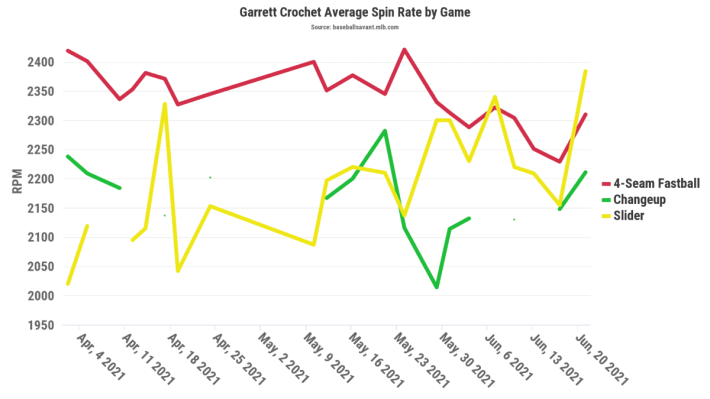Matt Thornton is one of four pitchers to make at least 500 appearances for the White Sox. The others are guys that parents and grandparents told their kids about, whether in front Cooperstown plaques (Red Faber, 669; Ted Lyons, 595) or merely at home (Wilbur Wood, 578).
Thornton is fourth with 512, and he made it into the 500 Club via a simple path: 96-mph fastballs from the left side for an inning at a time, usually against Grady Sizemore and Travis Hafner. At his peak, the four-seamer accounted for 90 percent of his output, and while a decent breaking ball would've helped him miss more bats and avoid the Thornton Luck that often reared its head in save situations, his fastball generated plenty of value by itself over his eight years on the South Side.
Statcast only catches the last year of Thornton's career in San Diego, so we don't know if we would've been able to point to spin rate or ride for the secrets to his success during his prime, or whether that well-located Easy Heat was merely such a novelty from the left side during that decade. Would Thornton have a career of note if he emerged 15 years later? Or does Thornton hitting 98 then means he touches 102 now?
These questions came to mind while watching Garrett Crochet's 96-mph fastballs suffer rapid disrespect from a last-place Pirates team on Tuesday. He gave up four hits over the course of 10 pitches -- two singles on his fastball, followed by a bunt single on his fastball.
Why didn't Yasmani Grandal call more sliders? Well, that's the pitch that the Astros shocked for a lineout, a single and double over the course of three batters in the ninth inning for their walk-off winner last Friday. Besides, when Grandal finally tried the breaking ball on Tuesday, it was pounded through the left side for a two-run single that gave Pittsburgh the lead.
After giving up just one earned run over his first 20⅓ innings for a 0.44 ERA, Crochet's given up six runs over his last 2⅓ innings. Here's where we note that his FIP was 2.62 during those first 18 appearances, and now his ERA is 2.78 three games later. Some level of regression is to be expected, banal as that explanation may be.
The tough thing about chalking it up to regression is that I still don't exactly know what Crochet should regress to. He was 101-sitting phenomenon when the White Sox called him up last year, at least until his forearm cried for help during Game 3 of the Wild Card Series. When he returned to the mound hovering around 98 in the spring, it prompted some questions about his condition, but he also still had the stuff to succeed.
But his fastball on Tuesday needed rounding help to reach 96, and the Pirates made it look underpowered with their reactions. Tony La Russa needed is willing to consider it a blip for the time being...
... and maybe it is, because Crochet is still trying to figure it all out. He just turned 22 two days ago, and he has just 26 games of professional experience to fall back on, all of which took place at the MLB level.
The problem is that "figuring it out" is already an immense task. It's also one that might've become even more complicated in the middle of the season as Major League Baseball issued its foreign-substance crackdown in early June.
One can't look at Crochet's Baseball Savant page and draw easy conclusions about what he may or may not have been doing. His spin rate plummeted from 2020 to 2021, but that's because his velocity also dropped, and they go hand-in-hand (see Carlos Rodón's page for the inverse). On top of that, Crochet's heat has fluctuated outing to outing, his slider has taken different shapes, and he's also missed time with a minor back issue.
His spin rate is down from May to June ...

... but there's also too much noise to know whether this is a cause of his struggles or a symptom of his inconsistency, because the spin rate started its slide in late May. That's also the time he started appearing for more than one inning at a time, so this could all be a manifestation of fatigue management more than anything.
There's too much we don't know about Crochet, which is the reason why I've been generally bearish about his ability to contribute across a six-month season at this stage in his career. If it's a specific critique of Crochet, it's only because of the forearm issue that bubbled up last October. The other doubts stem from the difficulty of the fast track. Chris Sale made it look like nothing, but Rodón and Carson Fulmer will tell you that it's really damned hard to figure out a final form on the fly. Now here's Crochet on the fastest track of anybody, with little collegiate experience, no time in the minors, and suddenly a midseason rule change to complicate things further.
It's a little unfair to single out Crochet when Aaron Bummer followed him with his own brand of inconsistency, Evan Marshall and Codi Heuer have both faltered on and off from the right side, Matt Foster can't rediscover even his mid-innings usefulness from last year, and Michael Kopech is eligible for the White Sox's class-action lawsuit against their hamstring manufacturer.
Crochet only draws attention because his final form remains undetermined. Four of the five pitchers in the above paragraph are relief-only. Crochet might be, too, but when the White Sox chose this fate this soon, it's because they imagined that triple-digit sensation from 2020. In his current form, Baseball Savant's automatically generated list of comparable players includes 2021 Ross Detwiler. Crochet's limited sample makes it hard to take such a specific pull seriously, but if Crochet is now sitting 96 and failing to miss bats in the zone, it's probably worth taking any and all cues to reevaluate whether this is the future everybody wants for him.
(Photo by John Cordes/Icon Sportswire)






